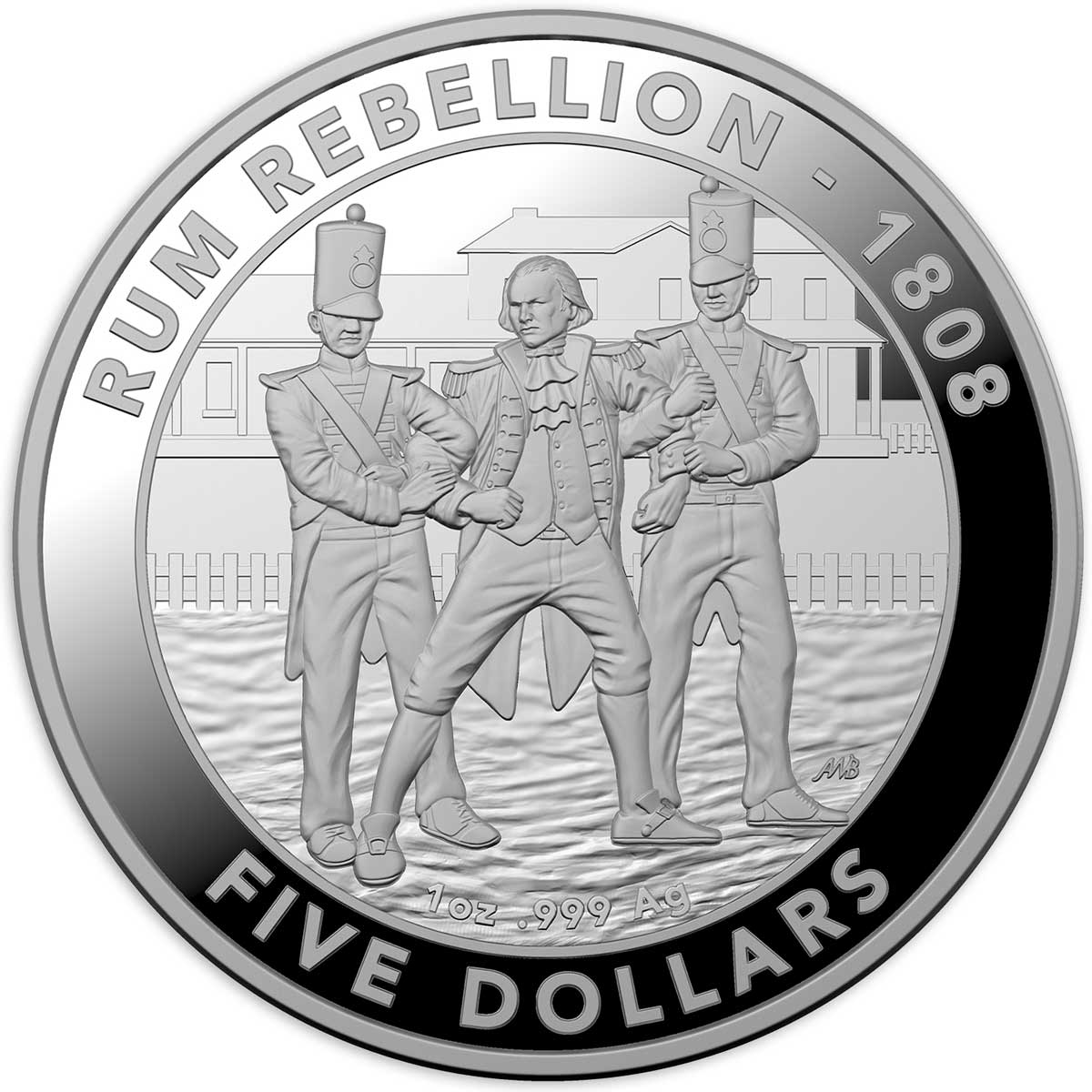Royal Australian Mint portrays the countries rebellious history on a new silver coin trio
You would think that being surrounded by a selection of flying, swimming and running wildlife that is poisonous, venomous, or just plain mean, would make the average Australian love his fellow man. Unfortunately, the colonists decided mutiny and rebellion was a more colourful way to fill their fledgling history books – hardly surprising given the tough environment.
The Royal Australian Mint (RAM) is highlighting some of the more pivotal events in their new Mutiny and Rebellion series of three silver coins. The first coin is available now and is an event easily the most famous of the trio, the Mutiny on the Bounty. The subject of numerous movies, the Mutiny on the Bounty is no stranger to numismatics either, even appearing on a bullion coin a few years ago. The design of this one is far superior, however. These renders show a beautifully crafted piece of artwork, exhibiting tons of detail and a fine mastery of anatomy and perspective.
The next coin will be The Rum Rebellion (shipping 3rd June), followed by the Eureka Stockade (August 5th). Both are full of excellently rendered human figures, but we have to say the Bounty coin is our favourite here. The obverse remains common to the series and features the Ian Rank Broadley effigy of Queen Elizabeth II. The packaging comprises of an excellent box, all placed inside some neat, themed shipper sporting some great art. Of course, a certificate of authenticity resides within.
All told, a neat series of 1oz silver coins, free of unnecessary adornment and all the better for it. Selling for $100 AUD each, some 1,500 of each design will be struck, and a collectors box to hold the three (strangely still in their shippers) is out for a further $15.00.
The mutiny on the Royal Navy vessel HMS Bounty occurred in the south Pacific on 28 April 1789. Disaffected crewmen, led by Acting Lieutenant Fletcher Christian, seized control of the ship from their captain Lieutenant William Bligh and set him and 18 loyalists adrift in the ship’s open launch. The mutineers variously settled on Tahiti or on Pitcairn Island. Bligh meanwhile completed a voyage of more than 3,500 nautical miles (6,500 km; 4,000 mi) in the launch to reach safety, and began the process of bringing the mutineers to justice.
Bounty had left England in 1787 on a mission to collect and transport breadfruit plants from Tahiti to the West Indies. A five-month layover in Tahiti, during which many of the men lived ashore and formed relationships with native Polynesians, proved harmful to discipline. Relations between Bligh and his crew deteriorated after he began handing out increasingly harsh punishments, criticism and abuse, Christian being a particular target. After three weeks back at sea, Christian and others forced Bligh from the ship. Twenty-five men remained on board afterwards, including loyalists held against their will and others for whom there was no room in the launch.
After Bligh reached England in April 1790, the Admiralty despatched HMS Pandora to apprehend the mutineers. Fourteen were captured in Tahiti and imprisoned on board Pandora, which then searched without success for Christian’s party that had hidden on Pitcairn Island. After turning back towards England, Pandora ran aground on the Great Barrier Reef, with the loss of 31 crew and four prisoners from Bounty. The 10 surviving detainees reached England in June 1792 and were court martialled; four were acquitted, three were pardoned and three were hanged.
Christian’s group remained undiscovered on Pitcairn until 1808, by which time only one mutineer, John Adams, remained alive. Almost all his fellow-mutineers, including Christian, had been killed, either by each other or by their Polynesian companions. No action was taken against Adams; descendants of the mutineers and their Tahitian captives live on Pitcairn into the 21st century. The generally accepted view of Bligh as an overbearing monster and Christian as a tragic victim of circumstances, as depicted in well-known film accounts, has been challenged by late 20th- and 21st-century historians from whom a more sympathetic picture of Bligh has emerged.
The Rum Rebellion of 1808 was the only successful armed takeover of government in Australian history. During the 19th century, it was widely referred to in Australia as the Great Rebellion. On 26 January 1808, 20 years after Arthur Phillip’s First Fleet of convicts founded Sydney as the first European settlement in Australia, the New South Wales Corps under the command of Major George Johnston, working closely with John MacArthur, deposed the Governor of New South Wales, William Bligh.
Bligh’s stifling of the colony’s rum traffic gave the rebellion its name, though other issues were also involved. Bligh had alienated the NSW Corps by accusing it of corruption and ineptitude, and his arrest of John Macarthur over grazing land for sheep and his attempted manipulation of commodities prices, split the colony.
Later in 1810, the corps was recalled to England and Bligh was vindicated with Johnston being dismissed from service in 1811, and Macarthur unable to return to New South Wales, for fear of facing charges, until 1817. Afterwards, the military ruled the colony, with the senior military officer stationed in Sydney acting as the lieutenant-governor of New South Wales until the arrival from Britain of Major-General Lachlan Macquarie as the new governor at the beginning of 1810.
The Eureka Rebellion was a rebellion in 1854, instigated by gold miners in Ballarat, Victoria, Australia, who revolted against the colonial authority of the United Kingdom. It culminated in the Battle of the Eureka Stockade, which was fought between miners and the colonial forces of Australia on 3 December 1854 at Eureka Lead and named for the stockade structure built by miners during the conflict. The rebellion resulted in the deaths of at least 27 people, the majority of whom were rebels.
The rebellion was the culmination of a period of civil disobedience in the Ballarat region during the Victorian gold rush with miners objecting to the expense of a miner’s licence, taxation via the licence without representation, and the actions of the government, the police and military. The local rebellion grew from a Ballarat Reform League movement and culminated in the erection by the rebels of a crude battlement and a swift and deadly siege by colonial forces.
Mass public support for the captured rebels in the colony’s capital of Melbourne when they were placed on trial resulted in the introduction of the Electoral Act 1856, which mandated suffrage for male colonists in the lower house in the Victorian parliament. This is considered the second instituted act of political democracy in Australia. Female colonists of South Australia were awarded suffrage 5 years later on condition of owning property, much in the way men did not have full suffrage in the absence of property ownership. As such, the Eureka Rebellion is controversially identified with the birth of democracy in Australia and interpreted by some as a political revolt.
PRESS RELEASE
Today, the Royal Australian Mint (the Mint) launched the first coins of a new limited edition commemorative coin series, featuring the mutiny on the HMS Bounty, The Rum Rebellion and The Eureka Stockade at the National Maritime Museum in Sydney. Royal Australian Mint General Manager of Sales, Marketing and Distribution, Mark Cartwright said these special coins mark key moments in Australian history.
“This unique and artistically detailed coin series acknowledges historical events and people from Australia’s tempestuous colonial era, a time that resulted in mutiny and rebellion but contributed to eventual egalitarian democracy and rule of law in our nation,” said Mr Cartwright.
The first coin of the series focuses on the story of the HMS Bounty’s Captain William Bligh; the second coin features The Rum Rebellion and the third coin features The Eureka Stockade. The coins were unveiled by Head of Research at the Australian National Maritime Museum, Dr Nigel Erskine, Royal Australian Mint General Manager of Sales, Marketing and Distribution, Mark Cartwright and Royal Australian Mint Coin Designer, Adam Ball. Dr Nigel Erskine, said the release of the Mutiny on the Bounty five and one dollar coins is testimony to the continuing fascination in our own time, with the life of William Bligh – the subject of a new major exhibition ‘Bligh – Hero or Villain’ opening at the museum in July.
“In an era that witnessed the American War of Independence, the French Revolution and the rise and fall of Napoleon Bonaparte, William Bligh’s story would have been largely unremarkable had it not been for a mutiny aboard his ship, the Bounty, that made his name a household word and his actions the subject of fierce controversy that followed him for the rest of his life,” said Dr Erskine.
“It was a privilege to design and sculpt the ‘Mutiny and Rebellion’ coin series. Using state-of-the-art software and hardware often used in the video game and film industry, I was determined to capture this part of our history as creatively as possible with the sense of capturing a moment in history as if it were being photographed using the extremely high fidelity that this technology can achieve,” said Mr Ball.
The Mutiny On The Bounty coins are available for purchase from 6 May 2019, The Rum Rebellion coins are available for purchase from 3 June 2019 and The Eureka Stockade coins are available for purchase from 5 August 2019, as well as Mutiny and Rebellion – 3 Coin Collection Case, which is available for purchase from 6 May 2019. The coins are Australian legal tender and can be purchased from the Mint’s website or Contact Centre (1300 652 020).
| SPECIFICATION | |
| DENOMINATION | $5 Australia |
| COMPOSITION | 0.999 silver |
| WEIGHT | 31.1 grams |
| DIMENSIONS | 40.0 mm |
| FINISH | Proof |
| MODIFICATIONS | None |
| MINTAGE | 1,500 |
| BOX / COA | Yes / Yes |











Leave A Comment